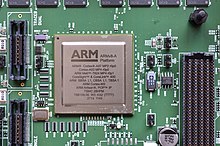
Back ARM big.LITTLE Catalan ARM big.LITTLE Czech Big.LITTLE German ARM big.LITTLE Spanish Big.LITTLE French ARM big.LITTLE Hungarian Big.LITTLE Japanese Big.LITTLE Korean Big.LITTLE Chinese

ARM big.LITTLE is a heterogeneous computing architecture developed by Arm Holdings, coupling relatively battery-saving and slower processor cores (LITTLE) with relatively more powerful and power-hungry ones (big). The intention is to create a multi-core processor that can adjust better to dynamic computing needs and use less power than clock scaling alone. ARM's marketing material promises up to a 75% savings in power usage for some activities.[1] Most commonly, ARM big.LITTLE architectures are used to create a multi-processor system-on-chip (MPSoC).
In October 2011, big.LITTLE was announced along with the Cortex-A7, which was designed to be architecturally compatible with the Cortex-A15.[2] In October 2012 ARM announced the Cortex-A53 and Cortex-A57 (ARMv8-A) cores, which are also intercompatible to allow their use in a big.LITTLE chip.[3] ARM later announced the Cortex-A12 at Computex 2013 followed by the Cortex-A17 in February 2014. Both the Cortex-A12 and the Cortex-A17 can also be paired in a big.LITTLE configuration with the Cortex-A7.[4][5]
- ^ "big.LITTLE technology". ARM.com. Archived from the original on 22 October 2012. Retrieved 17 October 2012.
- ^ Cite error: The named reference
Auto4J-1was invoked but never defined (see the help page). - ^ Cite error: The named reference
cortex-a50 announcewas invoked but never defined (see the help page). - ^ "ARM's new Cortex-A12 is ready to power 2014's $200 midrange smartphones". The Verge. April 2014.
- ^ "ARM Cortex A17: An Evolved Cortex A12 for the Mainstream in 2015". AnandTech. April 2014.